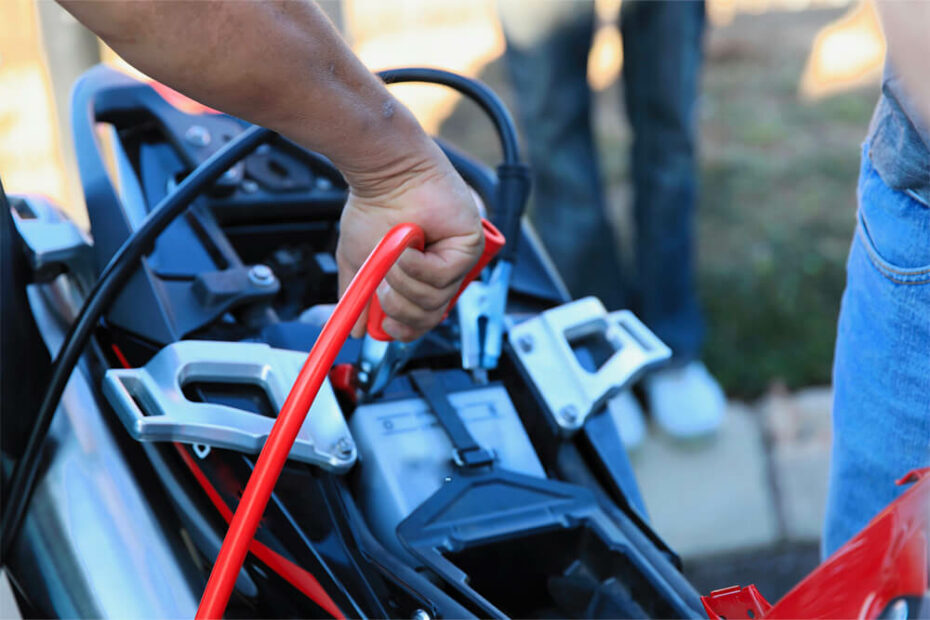You should have certainly found your motorcycle battery discharged during winter, at least once.
Why, even with no use, does your motorcycle battery discharge?
How a motorcycle battery discharges even with no use
One of the main causes of motorcycle battery winter discharges is certainly cold temperatures. In fact, batteries suffer low temperatures and cold constrains the batteries sourced current when the vehicle is started.
Another cause of discharged motorcycle batteries is the minimum absorption from the vehicle electronics during the inactivity period. The electronical central units, the GPS system, the alarm system and black box some motorcycles have with their insurance policies, have a minimum absorption that, after a long inactivity time, may deeply discharge the battery. To avoid this problem, we can leave our motorcycle stored during these periods with the battery disconnected, or even better, connect its battery to battery charge keeper
Solutions to keep your motorcycle battery charged
Keeping your motorcycle battery charged is essential to ensure that your bike starts up smoothly every time you need it. Start your motorcycle and go for a ride, or at least keep the engine on and the motorcycle still.
Several alternators well charge the motorcycle on a start, so that’s not necessary to keep the engine revving.
If it’s not possible to charge through the motorcycle electric system, you could disconnect the battery in case a long motorcycle stop is forecasted. If you think you’ll not going to use your vehicle for at least one month then disconnect the engine battery.
If you have an electrical socket near the motorcycle storing place then you could use a charge keeper, ensuring a longer life to your battery.
Discover how a battery keeper can save you from low battery woes
A battery keeper basically is a smaller battery charger with a specific aim: to supply a low amperage charge only when needed, keeping then always at the right tension.
The keepers generally offer two ways to connect to a battery:
- through classic “crocodile” clamps, as those used in every battery charger
- using a permanent solution that allows the connection of an air/watertight (in inglese si dice stagno che difende dall’acqua oppure dall’aria, in questo caso sarebbe dall’acqua? Watertight?) connector directly to battery cables
Easy solutions for a discharged motorcycle battery
If you have not followed any of the above listed advice, then it may happen you have your motorcycle battery discharged.
Luckily, it is not always necessary to replace the discharged battery.
Several motorcycle battery models can be bought at affordable prices, then with a reasonable expense you may buy a new battery to replace the old one. Often if the battery is discharged it is not necessary to replace it: it should only be needed to recharge it.
To charge your motorcycle battery you have to buy a battery charger.
An intelligent electronic battery charger is a small device, when connected to the battery on the positive and negative poles and to the current socket, then it works on its own.
It measures the charge level and acts consequently. All these devices grant a maximum security having the necessary short-circuit and overcharge protections and are equipped with a panel showing the different battery charging phases.
The most recent models can detect if the battery under charge is damaged and they can try to restore it through the desulphation mode allowing battery regeneration. This operation will not always succeed, as it depends on the battery conditions. The standard charging time is 6-8 hours, max. 1 night.
How to properly charge your motorcycle battery to grant a long life
Your motorcycle battery charge has to be done through constant current source and rising tension, followed by a second phase of constant tension and decreasing current. For batteries with 12 V nominal tension the charging tension is 13,8 V. the charging current must be limited to 1/10, at maximum 1/5 of the battery capacity.
The charge is done, when possible, by taking off the single element caps.
Lots of the current batteries on the market are hermetic, in these models in fact there are no caps to take off. Motorcycle batteries have, anyway, an additional air hole that must be firmly connected to a small tube through the soil, once installed.
To proceed with battery dismantling, it is advisable to disconnect the negative pole first and then the positive one, and in the other way around if you have to install the battery on the vehicle, and then connect the battery to the electrical source.
As in the charging process explosive hydrogen is produced, avoid any spark near the battery. During the charging phase the electrolytic solution starts boiling, it is then advisable to keep the working area areated.
It is then advisable to check the battery temperature to be not above 45-50°C.
It is advisable to avoid the charge for a longer period than indicated, as this will mean water dissotiation in a solution and an active mass loss for electrodes deterioration, with an additional explosion danger risk.
It must always be under the solution level, that must overpass the internal plates of at least 5 mm, especially after a long charging operation.
